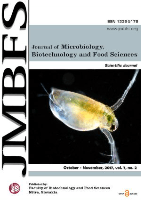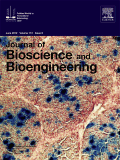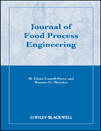
PROCESS BIOCHEMISTRY
Scope & Guideline
Fostering collaboration in the realm of biochemical sciences.
Introduction
Aims and Scopes
- Biotechnological Innovations:
The journal emphasizes advancements in biotechnological processes, including enzyme technology, microbial fermentation, and metabolic engineering, to enhance production efficiencies and develop novel bioproducts. - Sustainable Process Development:
Research published in this journal often focuses on sustainable practices in bioprocessing, including waste valorization, bioenergy production, and the development of green solvents and extraction methods. - Biochemical Characterization:
A core area of interest is the biochemical characterization of enzymes and other biocatalysts, exploring their properties, mechanisms, and applications in industrial processes. - Food and Nutraceutical Applications:
The journal includes studies related to food science, particularly in the extraction and characterization of bioactive compounds, functional foods, and their health benefits. - Environmental Biotechnology:
Research on the use of bioprocesses for environmental applications, such as bioremediation and waste treatment, is a significant focus area, showcasing the role of biotechnology in addressing environmental challenges. - Interdisciplinary Approaches:
The journal encourages interdisciplinary research that combines biochemistry with other fields such as materials science, nanotechnology, and computational biology to address complex biotechnological challenges.
Trending and Emerging
- Enzyme Engineering and Modification:
There is an increasing focus on the engineering and modification of enzymes to enhance their stability, efficiency, and specificity for industrial applications, driven by advancements in protein engineering techniques. - Microbial Consortia and Synergistic Interactions:
Research exploring the use of microbial consortia and their synergistic interactions for improved bioprocessing outcomes is gaining traction, highlighting the importance of ecological approaches in biotechnology. - Biomaterials and Nanotechnology:
The integration of nanotechnology in the development of biomaterials for drug delivery, tissue engineering, and biocatalysis is an emerging trend, showcasing the potential of nanomaterials in enhancing biotechnological applications. - Sustainable and Green Chemistry Approaches:
There is a marked increase in research focusing on sustainable and green chemistry practices, including the use of deep eutectic solvents and eco-friendly extraction methods, reflecting a broader commitment to environmental sustainability. - Bioinformatics and Computational Biology:
The application of bioinformatics and computational biology in predicting enzyme functions, metabolic pathways, and bioprocess optimizations is on the rise, indicating a trend towards data-driven research in biotechnology. - Valorization of Agricultural Waste:
Research on the valorization of agricultural waste into valuable bioproducts, such as biofuels, bioplastics, and biochemicals, is emerging, driven by the need for sustainable waste management solutions.
Declining or Waning
- Traditional Biochemical Methods:
There is a noticeable decline in the publication of studies focusing solely on traditional biochemical methods without incorporating innovative or interdisciplinary approaches. This suggests a shift toward more integrated methodologies. - Basic Enzymology Studies:
While enzyme studies remain important, there has been a decrease in basic enzymology research that does not link to practical applications or biotechnological advancements, indicating a preference for applied research. - Conventional Fermentation Techniques:
Research centered on conventional fermentation techniques without novel enhancements or optimizations is becoming less frequent, as the field moves towards more advanced and efficient fermentation strategies. - Single-Organism Studies:
Studies focusing exclusively on single organisms without broader ecological or metabolic context are declining, reflecting an increased interest in understanding complex microbial interactions and consortia. - Static Laboratory Studies:
The prevalence of static laboratory studies that do not simulate real-world bioprocess conditions is waning, as there is a growing emphasis on dynamic and scalable bioprocessing research.
Similar Journals

BIOTECHNOLOGY AND APPLIED BIOCHEMISTRY
Illuminating Pathways in Biotechnology Advancements.BIOTECHNOLOGY AND APPLIED BIOCHEMISTRY, published by Wiley, is a renowned journal that bridges the gap between fundamental research and practical applications in the fields of biochemistry and biotechnology. With an ISSN of 0885-4513 and an E-ISSN of 1470-8744, this journal has been instrumental since its inception in 1986, focusing on diverse topics including applied microbiology, drug discovery, and process chemistry. The journal is currently recognized in various categories with impressive quartile rankings, showcasing its influence with placements in Q2 for applied microbiology, biotechnology, and biomedical engineering, among others. Researchers and professionals benefit from its comprehensive scope and critical insights into the latest advancements in these domains. Although not an open-access journal, it provides invaluable access options for academic institutions and professionals seeking to stay at the forefront of biotechnology innovations. Its commitment to presenting quality research facilitates the growth of knowledge and fosters collaborations across disciplines, making it an essential resource for anyone invested in the rapidly evolving landscape of biosciences.

WORLD JOURNAL OF MICROBIOLOGY & BIOTECHNOLOGY
Elevating Research in Microbiology and BiotechnologyWORLD JOURNAL OF MICROBIOLOGY & BIOTECHNOLOGY, published by Springer, serves as a pivotal forum for advancing the fields of microbiology and biotechnology since its inception in 1990. Located in the Netherlands, this esteemed journal has secured a prominent position in the academic landscape, recognized for its strong impact factor and prestigious Q2 category rankings across disciplines such as Applied Microbiology, Biotechnology, and Physiological Sciences. Researchers and professionals utilize this journal to disseminate innovative findings and explore emerging technologies that are transforming the scientific landscape. With a robust submission rate and high visibility among the academic community, the journal fosters interdisciplinary collaboration, encouraging discussions that bridge gaps between theory and practical applications. As it converges into 2024, the WORLD JOURNAL OF MICROBIOLOGY & BIOTECHNOLOGY continues to be a vital resource for scholars aiming to enhance our understanding of microbial processes and biotechnological advances.

Journal of Microbiology Biotechnology and Food Sciences
Advancing the frontiers of microbiology and food innovation.Journal of Microbiology Biotechnology and Food Sciences, published by SLOVAK UNIV AGRICULTURE NITRA, is a distinguished open-access journal dedicated to advancing scholarship in the interrelated fields of microbiology, biotechnology, and food sciences. With an ISSN of 1338-5178, this journal has been accessible to researchers worldwide since 2011, providing a platform for innovative studies that contribute to the understanding of microbial processes, biotechnological advancements, and food science applications. As reflected in its 2023 category quartiles, the journal holds notable positions in Biotechnology (Q3) and Food Science (Q3), and while it ranks in the lower quartiles for Microbiology (Q4) and Molecular Biology (Q4), it is committed to enhancing its impact within these domains. The journal encourages the submission of high-quality research articles, reviews, and short communications that address critical issues in these fields, making it an essential resource for academics, industry professionals, and students alike. Emphasizing both foundational research and practical applications, the Journal of Microbiology Biotechnology and Food Sciences stands as a vital contributor to the scientific discourse, fostering innovation and collaboration among researchers aiming to solve pressing challenges in food safety, biotechnology development, and microbial studies.

FOOD SCIENCE AND BIOTECHNOLOGY
Fostering Collaboration for Global Food SolutionsFOOD SCIENCE AND BIOTECHNOLOGY, published by the Korean Society of Food Science & Technology (KOSFOST), stands as a prominent peer-reviewed journal dedicated to advancing knowledge in the fields of food science, biotechnology, and applied microbiology. With ISSN 1226-7708 and E-ISSN 2092-6456, this journal serves as a pivotal platform for disseminating high-impact research from South Korea and beyond, reflecting a robust Q2 ranking in multiple categories including Applied Microbiology and Biotechnology, Biotechnology, and Food Science as of 2023. The journal's influence is further emphasized by its positions in various Scopus ranks, where it showcases a commendable percentile ranking in Agricultural and Biological Sciences and Biochemistry. Although access options remain limited, the journal’s objectives revolve around the publication of innovative research, fostering interdisciplinary collaboration, and facilitating the exchange of ideas among a diverse community of researchers, professionals, and students. Whether you are involved in food technology, microbial biotechnology, or nutritional sciences, FOOD SCIENCE AND BIOTECHNOLOGY are instrumental in shaping the future of these critical fields, propelling advancements that enrich our understanding of food systems and health.

Applied Biological Chemistry
Exploring Complex Biochemical Processes with Clarity.Applied Biological Chemistry, published by SPRINGER SINGAPORE PTE LTD, is a premier open access journal that has been serving the biological sciences community since 2016. With an ISSN of 2468-0834 and E-ISSN of 2468-0842, this journal is committed to disseminating high-quality research in the fields of Biochemistry, Genetics, Molecular Biology, and Organic Chemistry. The journal holds a commendable position within the scientific community, ranking in the Q2 quartile for both Biochemistry and Organic Chemistry niches as of 2023. It aims to foster innovative research and facilitate discussions that propel the understanding of complex biochemical processes and molecular techniques. By providing open access to its contents, Applied Biological Chemistry ensures that valuable research is readily available to researchers, professionals, and students globally, encouraging collaboration and knowledge sharing in this rapidly evolving discipline. Its pivotal role in enhancing scientific communication in the Netherlands and beyond is further underscored by a steadily increasing impact in the academic arena.

JOURNAL OF BIOSCIENCE AND BIOENGINEERING
Advancing the frontiers of bioscience and engineering.The JOURNAL OF BIOSCIENCE AND BIOENGINEERING, published by the SOC BIOSCIENCE BIOENGINEERING JAPAN, is an esteemed peer-reviewed journal dedicated to advancing knowledge in the fields of applied microbiology, biotechnology, and bioengineering. With its ISSN of 1389-1723 and E-ISSN 1347-4421, this journal has been providing a platform for innovative research since its inception in 1991, maintaining its relevance through periodic updates and a scope that encompasses various aspects of bioscience and engineering. The journal boasts a notable impact factor, reflecting its contributions to the Q2 and Q3 quartiles in relevant categories as of 2023, which positions it amongst the well-regarded publications in its field. Researchers and professionals can access its rich archive through open access options, ensuring wide dissemination of pivotal studies. With its address rooted in Osaka University, Japan, the journal serves as a vital resource for scientists and scholars committed to pushing the boundaries of biosciences and engineering.

JOURNAL OF FOOD PROCESS ENGINEERING
Transforming food processing with cutting-edge research.JOURNAL OF FOOD PROCESS ENGINEERING, published by WILEY, is a prestigious academic journal dedicated to advancing the field of food processing through innovative engineering research and practical applications. With an ISSN of 0145-8876 and an E-ISSN of 1745-4530, this journal serves as a crucial platform for researchers and professionals focusing on the intersection of chemical engineering and food science. Operating in the United States and established in 1977, it has gained a reputation for its rigorous peer-review process and high-quality publications, reflected in its Category Quartiles of Q2 in both Chemical Engineering (miscellaneous) and Food Science for 2023. The journal is also well-positioned within the Scopus rankings, holding the 104th spot out of 389 in Agricultural and Biological Sciences and the 82nd in General Chemical Engineering. While it currently does not offer Open Access options, the JOURNAL OF FOOD PROCESS ENGINEERING remains an indispensable resource for those looking to explore critical studies and developments that shape food processing technologies by the year 2024 and beyond.

Microbial Cell Factories
Innovating Tomorrow's Biotechnology with Microbial Cell FactoriesMicrobial Cell Factories is a premier peer-reviewed journal dedicated to the field of applied microbiology and biotechnology, published by BMC in the United Kingdom since 2002. With an impressive impact factor, this journal has consistently ranked within the Q1 category across multiple disciplines, including Applied Microbiology, Bioengineering, and Biotechnology, showcasing its significance in the scientific community. The journal’s commitment to open access ensures that innovative research is freely available to researchers, professionals, and students worldwide, fostering collaboration and knowledge dissemination. With a strong presence in Scopus rankings, Microbial Cell Factories is recognized for its contributions to advancing the understanding and application of microbial processes in production systems, making it an essential resource for those involved in the microbiological and biotechnological fields.

BIOTECHNOLOGY AND BIOPROCESS ENGINEERING
Elevating Knowledge in Biotechnology and BioengineeringBIOTECHNOLOGY AND BIOPROCESS ENGINEERING, published by the Korean Society for Biotechnology and Bioengineering, is a prominent journal in the fields of applied microbiology, biotechnology, bioengineering, and biomedical engineering. Since its inception in 1996, this journal has served as a vital platform for researchers and professionals, facilitating the dissemination of cutting-edge research and innovative applications related to bioprocesses and biotechnology systems. With an ISSN of 1226-8372, this journal is ranked within the Q3 quartile across several categories, demonstrating its relevance and impact in the academic community. Although it operates under traditional access modalities, the journal strives to provide quality and timely insights into the advancements in bioprocess technology and microbial applications, fostering a collaborative environment for knowledge exchange. Notably, it is indexed with a respectable presence on Scopus, making it a valuable resource for students and professionals seeking the latest developments in biotechnology. For more details, kindly refer to the Korean Science Technology Center, #704 Yeoksam-Dong, Gangnam-Ku, Seoul 135-703, South Korea.

JOURNAL OF BASIC MICROBIOLOGY
Connecting Ideas in Microbiology and BiotechnologyJOURNAL OF BASIC MICROBIOLOGY is a premier publication in the field of microbiology, published by WILEY since 1985. With a significant presence in Germany, this journal encompasses a wide spectrum of research topics, focusing on applied microbiology and biotechnology as well as diverse areas within medicine. Holding a commendable Q2 ranking in both its categories for 2023, it plays a crucial role in disseminating innovative findings and methodologies to the community. Researchers will find it to be an essential platform for sharing high-quality work, where it currently stands at rank #47 in the applied microbiology and biotechnology category, representing the 63rd percentile among international journals. The JOURNAL OF BASIC MICROBIOLOGY caters to a growing audience of professionals and students, offering insights essential for advancement in microbiological research and its applications. While it does not currently offer an Open Access option, it remains an influential outlet for academic excellence, continuously contributing to the development of the field through its rigorous peer-reviewed articles.